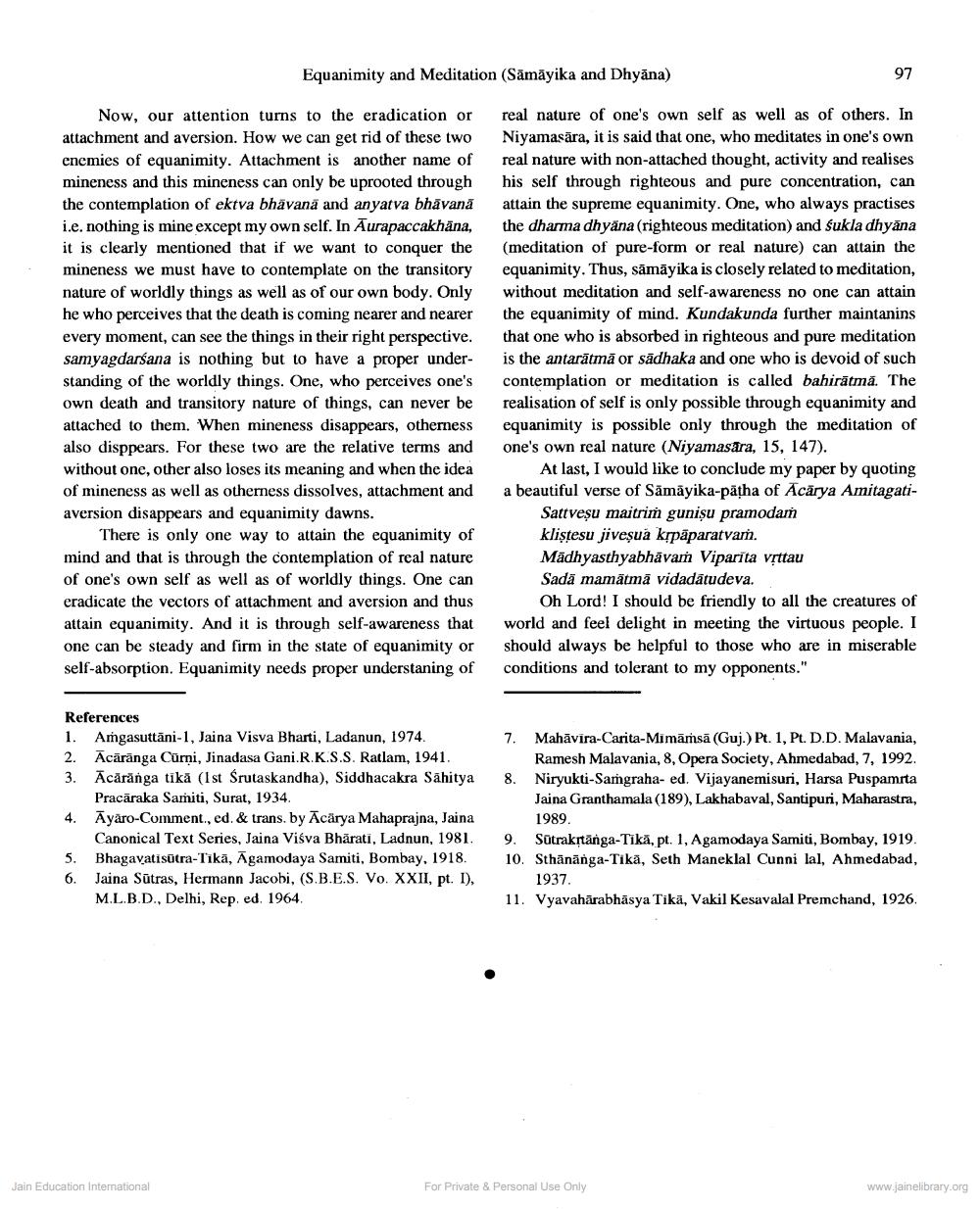Book Title: Equanimity And Meditation Samayika And Dhyana Author(s): Sagarmal Jain Publisher: Z_Jaina_Literature_and_Philosophy_a_Critical_Approach_001936_HR.pdf View full book textPage 2
________________ Equanimity and Meditation (Samayika and Dhyana) 97 Now, our attention turns to the eradication or attachment and aversion. How we can get rid of these two enemies of equanimity. Attachment is another name of mineness and this mineness can only be uprooted through the contemplation of ektva bhavana and anyatva bhavana i.e, nothing is mine except my own self. In Aurapaccakhana, it is clearly mentioned that if we want to conquer the mineness we must have to contemplate on the transitory nature of worldly things as well as of our own body. Only he who perceives that the death is coming nearer and nearer every moment, can see the things in their right perspective. samyagdarsana is nothing but to have a proper under standing of the worldly things. One, who perceives one's own death and transitory nature of things, can never be attached to them. When mineness disappears, otherness also disppears. For these two are the relative terms and without one, other also loses its meaning and when the idea of mineness as well as otheress dissolves, attachment and aversion disappears and equanimity dawns. There is only one way to attain the equanimity of mind and that is through the contemplation of real nature of one's own self as well as of worldly things. One can eradicate the vectors of attachment and aversion and thus attain equanimity. And it is through self-awareness that one can be steady and firm in the state of equanimity or self-absorption. Equanimity needs proper understaning of real nature of one's own self as well as of others. In Niyamasara, it is said that one, who meditates in one's own real nature with non-attached thought, activity and realises his self through righteous and pure concentration, can attain the supreme equanimity. One, who always practises the dharma dhyana (righteous meditation) and sukla dhyana (meditation of pure-form or real nature) can attain the equanimity. Thus, samayika is closely related to meditation, without meditation and self-awareness no one can attain the equanimity of mind. Kundakunda further maintanins that one who is absorbed in righteous and pure meditation is the antaratma or sadhaka and one who is devoid of such contemplation or meditation is called bahiratma. The realisation of self is only possible through equanimity and equanimity is possible only through the meditation of one's own real nature (Niyamasara, 15, 147). At last, I would like to conclude my paper by quoting a beautiful verse of Samayika-patha of Acarya Amitagati Sattvenu maitrim gunisu pramodam klistesu jivesua kipaparatvam. Madhyasthyabhavar Viparita vittau Sada mamatma vidadatudeva. Oh Lord! I should be friendly to all the creatures of world and feel delight in meeting the virtuous people. I should always be helpful to those who are in miserable conditions and tolerant to my opponents." References 1. Angasuttani-1, Jaina Visva Bharti, Ladanun, 1974. 2. Acaranga Curni, Jinadasa Gani.R.K.S.S. Ratlam, 1941. 3. Acaranga tika (1st Srutaskandha), Siddhacakra Sahitya Pracaraka Samiti, Surat, 1934. 4. Ayaro-Comment., ed. & trans. by Acarya Mahaprajna, Jaina Canonical Text Series, Jaina Visva Bharati, Ladnun, 1981. 5. Bhagavatisutra-Tika, Agamodaya Samiti, Bombay, 1918. 6. Jaina Sutras, Hermann Jacobi, (S.B.E.S. Vo. XXII, pt. I), M.L.B.D., Delhi, Rep. ed. 1964. 7. Mahavira-Carita-Mimamsa (Guj.) Pt. 1, Pt. D.D. Malavania, Ramesh Malavania, 8, Opera Society, Ahmedabad, 7, 1992. 8. Niryukti-Samgraha- ed. Vijayanemisuri, Harsa Puspamrta Jaina Granthamala (189), Lakhabaval, Santipuri, Maharastra, 1989. 9. Sutrakrtanga-Tika, pt. 1, Agamodaya Samiti, Bombay, 1919. 10. Sthananga-Tika, Seth Maneklal Cunni lal, Ahmedabad, 1937. 11. Vyavaharabhasya Tika, Vakil Kesavalal Premchand, 1926. Jain Education International For Private & Personal Use Only www.jainelibrary.orgPage Navigation
1 2
